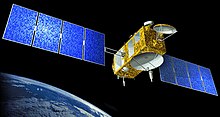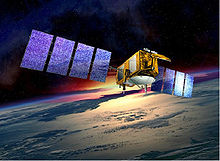Jason (satellite)
Jason is the name of a joint satellite program for marine observation of NASA (USA) and CNES (France).
Mission history
Jason 1 , the successor to the TOPEX / Poseidon satellite , was launched together with the TIMED earth observation satellite on December 7, 2001 with a Delta 7920 launcher from Vandenberg Air Force Base . Jason 2 , also known as OSTM (Ocean Surface Topography Mission), followed on June 20, 2008 with a Delta 7320 and Jason 3 on January 17, 2016 with a Falcon 9 , both also from Vandenberg Air Force Base.
All three satellites were positioned in 1340 km high circular orbits with an orbital inclination of 66 °. They were designed for a service life of at least 5 years each. Jason-1 and Jason-2 exceeded this expectation by six years, albeit with limited functionality in the last few years. They went out of operation in July 2012 and October 2019, respectively.
Instruments
The payloads are similar to those of TOPEX / Poseidon:
- Poseidon : Height measuring radars in C-band and Ku-band for measuring the sea surface
- Jason Microwave Radiometer (JMR): Determination of the water vapor to correct the altitude radar data from Poseidon .
- Doppler Orbitography and Radiopositioning Integrated by Satellite (DORIS): Position determination and correction data for Poseidon
- BlackJack : GPS receiver for position determination
- Laser retroreflector : ground-based position determination
Missionary tasks
Together with the RA-2 altimeter on ESA's Envisat satellite , Jason is the most important source of information for precise global predictions of ocean currents and waves. Jason has been specially optimized for observing the tropical seas, while other altimeters also cover mid-latitudes and the polar regions ( CryoSat ). Since altimeters can only measure along a relatively narrow ground track , it is advantageous to be able to combine height information from several instruments.
Jason’s special goals are:
- Measuring the sea level with an accuracy of better than 4 cm
- Observation of ocean currents, determination of wave heights and determination of wind speeds
- Prediction of El Niños
- Joint surveying tasks with TOPEX / Poseidon until its failure at the end of 2005
Technical specifications
The satellites are based on Alcatel's Proteus satellite bus . They are three-axis stabilized by magnetic torque rods (electromagnetic alignment with the earth's magnetic field by on-board coils) and have a drive system with a fuel supply of 28 kg hydrazine . They weigh around 500 kg, are 3 m high and are equipped with two solar panels that deliver 0.5 kW (Jason-2) and 1.0 kW respectively. The collected data are transmitted to earth via an S-band telemetry system at 613 (Jason-1) or 838.86 kbits / s (Jason-2).
Trivia
The name of the program is derived from the hero Jason from Greek mythology .
Web links
- NASA: OSTM / Jason-2
- Aviso: Jason-2
Individual evidence
- ↑ Gunter Krebs: Jason 2, 3 (OSTM). In: Gunter's Space Page. May 15, 2014, accessed February 4, 2015 .
- ↑ Jason 1 . Jet Propulsion Laboratory, accessed October 4, 2019.
- ^ Ocean Monitoring Satellite Mission Ends After 11 Successful Years . NASA press release dated October 4, 2019.
- ↑ Stanford University: GRAVITY PROBE B (English)
- ↑ Jonathan Amos: Key ocean mission goes into orbit. BBC, June 20, 2008, accessed February 4, 2015 .
- ↑ Jason in the Encyclopedia Astronautica , accessed February 4, 2015.
- ↑ NASA: Jason-1 - Fact Sheet. Retrieved February 4, 2015 .
- ↑ CNES: JASON-2 Satellite. October 28, 2008, accessed February 3, 2015 .



